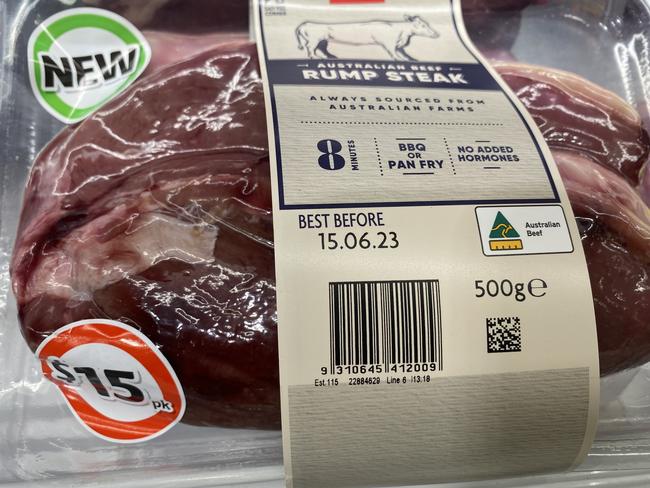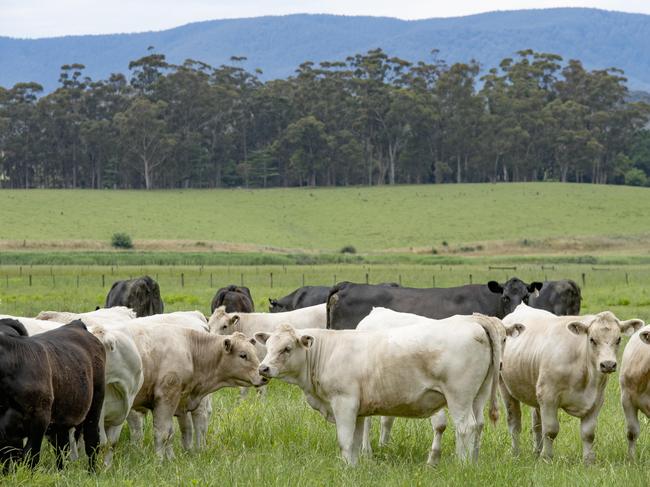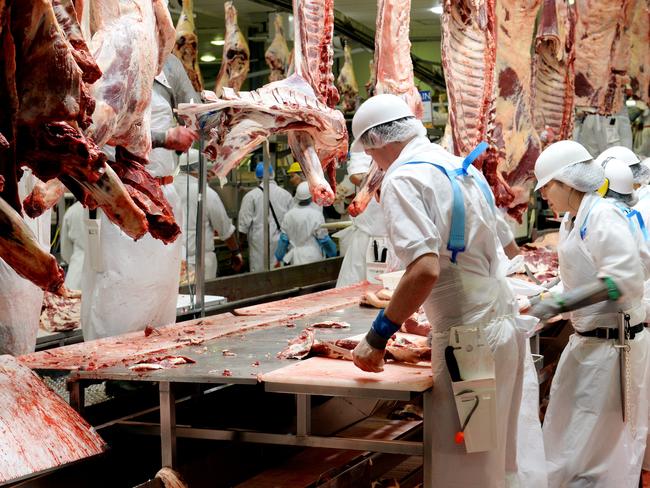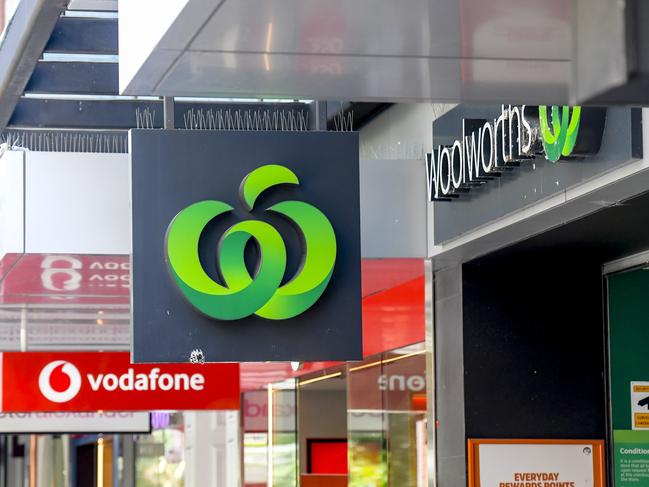‘Doesn’t pass the pub test’: Red meat prices at Coles and Woolies still too high, minister says
Coles and Woolworths have faced a stern warning to further drop the price of red meat in the lead-up to Christmas.
Retail
Don't miss out on the headlines from Retail. Followed categories will be added to My News.
Coles and Woolworths have been urged to further drop the price of red meat in the lead-up to Christmas, with the federal government warning it “doesn’t pass the pub test” that Aussies are still paying up to $20 per kilo for beef mince and $15 for a steak.
The supermarkets have come under fire in recent months after farmers questioned why the amount shoppers were paying remained virtually unchanged, even as livestock prices plummeted.
Caving to growing political pressure, Woolworths and Coles announced they were dropping prices on some red meat products by more than 20 per cent – but Agriculture Minister Murray Watt said it was not enough.
“It doesn’t pass the pub test that Australians are paying so much more for meat at the supermarket than farmers are getting for their livestock,” Mr Watt told news.com.au.
“I’ve been making clear for a couple of months now that the retailers should start dropping their prices. I’m glad David Littleproud and the Nationals have caught up and are now backing my calls. And I’m really pleased to see that Woolies have begun to cut the price of lamb, but we need to see more – from them and the other big supermarket chains.”

Supermarkets face grilling
It comes as the Senate is this week expected to establish an inquiry examining alleged “price gouging” by the supermarkets, after the Greens secured Labor’s support over the weekend, with the first hearings tipped for early 2024.
Both companies recorded profits in excess of $1 billion this year.
But the Nationals have argued the Senate inquiry will take too long and won’t go far enough, and instead reiterated calls for the Australian Competition and Consumer Commission (ACCC) to hold an inquiry into meat prices.
“The cost-of-living crisis is now, not next year, and the supermarkets have form on this, having gouged consumers during Covid,” Mr Littleproud said in a statement on Monday.
“An ACCC inquiry could have started the investigation before Christmas and actions from the price inquiry can be undertaken immediately, without having to wait for the completion of the inquiry. The Senate inquiry won’t start until 2024 and is mere window dressing for Labor and the Greens.”
Mr Littleproud said many families already struggling to afford groceries each week “might be feeling overwhelmed by the cost of an upcoming Christmas lunch, so it’s important the government acts swiftly”.
“Families need action immediately,” he said. “They deserve to see transparency in prices, especially given the enormous profits of supermarket giants.”
While livestock prices have fallen dramatically, the supply chain from paddock to plate is complex and adds costs at each step of the way.
According to Meat & Livestock Australia (MLA), typically it takes about eight months for lower livestock prices to filter through to the retail level – and even then, retail prices have historically remained much more stable than the wildly fluctuating livestock market.
“We know lower prices can take some time to filter from the farm gate to the checkout as long-term supply contracts wrap up, but supermarkets need to be more transparent,” Mr Watt said.
“The government’s review into the ACCC’s Food and Grocery Code is already underway and we’ll use this to apply pressure to the big supermarkets. But as I’ve said before, the supermarket chains shouldn’t wait until that review is finalised to offer fair prices on their shelves.”
The National Farmers’ Federation (NFF) welcomed the announcement of the Senate pricing inquiry. “We know what Australians are paying at the checkout, and we know what we’re receiving as farmers — but who clips the ticket in the middle is shrouded in secrecy,” said NFF president David Jochinke.
“We’d like to see a lot more transparency.”

Prices hit rock bottom
The beef industry benchmark, the eastern young cattle indicator (EYCI), fell more than 60 per cent from $9.06 per kilogram in January to a low of $3.49 in October, according to MLA data, while sheep prices fell around 80 per cent.
The EYCI hit a record of $11.91 in January last year.
The rapid plunge came as farmers rushed to offload their animals in the face of a sudden shift to dry weather – which reduces pasture availability and increases feed costs – after three consecutive wet years.
That led to an oversupply of animals in saleyards, coupled with low producer demand as farmers were not restocking their herds. Australia’s herd numbers are the highest in 15 years for sheep and nearly a decade for cattle.
Livestock in saleyards is sold to three groups of buyers – restockers, or farmers looking to buy animals to build their own herd, feedlot operators buying animals to fatten, and meat processors buying for slaughter.
“Restockers exiting the market has really driven the price lower,” said Stephen Bignell, market information manager at MLA.
The other thing that impacts domestic retail prices is the export market – Australia exports 60 per cent of its lamb and 73 per cent of its beef, which affects what retailers have to pay.
Currently domestic prices in the US are high following a severe drought.
“It’s not as simple as low livestock prices translate to low retail prices,” said Mr Bignell.
At the same time, bottlenecks in the abattoir sector – which was already struggling to attract workers – have led to long processing delays as firms struggle to ramp up capacity to absorb the sudden additional supply.
Higher international migration after Covid has started to ease the pressure, but it takes around eight months for new workers at meat processing facilities to complete their training.
Reduced saleyard demand for cattle from processors further drove down prices.
Queensland grazier Ian McCamley told the ABC in October that he had been fielding phone calls from producers “pleading with us to buy their cattle for any price”, while some livestock auctions were receiving no bids at all.
“I think the interesting part is, it’s crept up on people really quickly,” he said.

‘High prices fix high prices’
The perfect storm of factors causing the sudden collapse in prices has led to growing financial hardship in the sector.
“In two years incomes have gone down by more than 70 per cent,” Cliff Willis, a farmer and stock agent from Orange on the NSW central tablelands, told news.com.au.
“I had a client two years ago averaging $2367 for all his weaners [young calves]. If he had to sell them [today] he’d probably be flat average $600. We sell our lambs at this time of year. Two years ago we averaged $214, last year we averaged $195, this year we will be flat to average $120.”
Mr Willis acknowledged the market two years ago was “unsustainable”.
“Nothing fixes high prices like high prices,” he said.
“Anybody who bought cattle at those exorbitant prices a few years ago would have done money. To be fair they probably should have known, but people get excited. At the same time they were paying $200 to $300 for calves, some of the feeder steers [young cattle] were coming back at $2800, $2900 or more. But nothing ever lasts.”
The Australian Bureau of Agricultural and Resource Economics and Sciences (ABARES) forecasts the value of production for livestock and livestock products will fall by 12 per cent in 2023-24, from an estimated $36.1 billion in 2022-23.
“Average saleyard prices for cattle, sheep and lambs are forecast to fall in 2023-24 reflecting higher turn-off rates and lower restocker demand,” ABARES said.
“The onset of both El Nino and a positive Indian Ocean Dipole (IOD) have led to drier seasonal conditions across Australia. These climatic drivers are forecast to cause below average rainfall and above average temperatures across Australia over 2023-24.”
However, heavy rains over the past few weeks have seen cattle prices rebound by more than $2 to $5.75, close to levels seen in early 2020.
“It shows just how impactful rain is,” said Mr Bignell. “With this 200-cent increase we’ve made up a lot of the losses.”

‘Consumers willing to pay’
Tim Ryan, general manager of industry affairs the Australian Meat Industry Council (AMIC), which represents meat processors, has branded the “oversimplified” comparison between retail meat prices and the livestock market a “distraction”.
“Animals purchased through the saleyard pathway reflect the ebb and flow of restocker and feeder buyer demand, making the apparent swings in producer share of the retail dollar overly sensitive to feed and water availability,” he wrote in an op-ed on Monday.
“The saleyard is not a good indicator of what supermarkets or processors are buying.”
Mr Ryan noted that livestock prices had kicked up in recent days due to the east coast rains, but warned “heightened publicity on retail meat prices falling may make it difficult for the supermarkets to backtrack on discounts and pass on any rebound in livestock prices, as consumers have been prepped to expect cheap meat going into the festive season”.
“While the supermarkets can sustain low meat prices to bring in shoppers and make it up elsewhere, independent local butchers don’t have that option and may find it hard to compete, especially if livestock prices continue to climb,” he said.
Mr Ryan said that while blaming supermarkets or processors for the plight of farmers “may be easy, it simply ignores the massive swing in supply-side fundamentals”.
“Moreover, dropping retail prices won’t help the backlog of livestock in the system and pressure on farmgate prices,” he said.
“Processors don’t have an issue selling meat — exports have recently just hit a four-year high. The best way to alleviate the pressure on farmgate prices is to expand working processing capacity.”
He argued meat processors, which “wore the losses and paid through the teeth to keep plants operating and staff employed in the previous three years”, deserve to make a profit in the current environment.
“While it may leave a bitter taste for producers to see the price of lamb cutlets retail at $50 per kilo and saleyard lambs below $5 per kilo, both these prices are being driven by market forces,” he said.
“At a retail level, consumers have clearly been willing to pay $50 per kilo for cutlets.”

Supply chain costs increase
On Monday, Mr Watt called for Coles and Woolworths to freeze the price of leg ham to give families certainty before Christmas.
In October, both supermarkets announced on the same day that they were lowering the price of their half leg Christmas ham to $8 per kilo, the lowest price in several years.
A Coles spokeswoman said the supermarket was aware that “cost of living is front of mind for many Australians and we are committed to providing high-quality meat at lower prices”.
“Coles has been reducing the price of meat products including beef, lamb and our range of mince,” she said.
“We recently cut the price of lamb with savings between 20 per cent and 36 per cent. This week, we are offering Porterhouse steaks at $16, down from $18, while lamb midloin chops in Victoria, Queensland and Tasmania are at $18 per kilo, down from $22.”
She stressed that “the retail price of meat is not determined by the market price of livestock alone”. “While livestock prices have gone down, other costs in the supply chain have gone up, including transport, processing, packaging, and retailing the product on shelves,” she said.
“Most of our meat is sourced directly from farmers and producers, rather than at the saleyard. Therefore, industry market indicators do not reflect the price Coles pays for beef and lamb. We give our farmers certainty to ensure security of high-quality supply to our customers.”
A Woolworths spokeswoman said, “We don’t buy cattle from saleyards, so the low saleyard prices being quoted don’t reflect the reality of our supply chain. We’re currently paying our long term suppliers more than the industry market indicators for beef.”
She noted cattle markets are “prone to swing up and down sharply over short periods of time, with the market price indicators increasing by more than 50 per cent in the last two months”.
“To offer greater price certainty for both customers and suppliers, we partner directly with farmers, feedlots and livestock agents to agree on fair prices that reflect the high quality of their meat and market dynamics,” she said.
“We will continue to work with our long-term beef suppliers to forward contract our supply into 2024 to ensure they have confidence over the drier periods.”
Originally published as ‘Doesn’t pass the pub test’: Red meat prices at Coles and Woolies still too high, minister says





